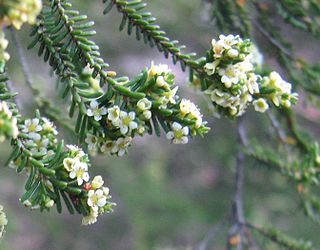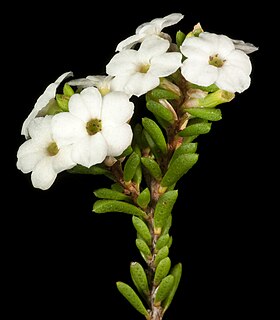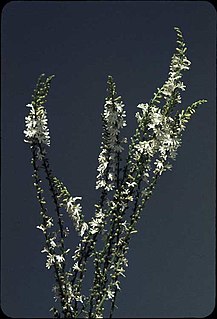John William Green is an Australian botanist.

Micromyrtus is a genus of shrubs, in the family Myrtaceae, described as a genus in 1865. The entire genus is endemic to Australia.

Crassula helmsii, known as swamp stonecrop or New Zealand pigmyweed, is an aquatic or semiterrestrial species of succulent plant in the family Crassulaceae. Originally found in Australia and New Zealand, it has been introduced around the world. In the United Kingdom, this plant is one of five introduced invasive aquatic plants which were banned from sale from April 2014. This is the first ban of its kind in the country. It is on the Global Register of Introduced and Invasive Species of eleven countries.
Micromyrtus grandis, the Severn River heath-myrtle, is a shrub in the myrtle family. It is found exclusively in the Severn River Nature Preserve and a property next to it, located around 60 km north-west of Glen Innes (Australia). It grows up to 1–4 metres tall, making it the largest plant in the genus Micromyrtus. The Severn River heath-myrtle is characterized by its fruit, which is 5-ribbed, and its broader leaves when compared to other nearby flora.
Verticordia helmsii is a flowering plant in the myrtle family, Myrtaceae and is endemic to the south-west of Western Australia. It is a shrub with most of its leaves clustered on short side branches and with small groups of scented creamish-white flowers in small groups along the branches.
Micromyrtus barbata is a plant species of the family Myrtaceae endemic to Western Australia.
Micromyrtus clavata is a plant species of the family Myrtaceae endemic to Western Australia.

Micromyrtus elobata is a plant species of the family Myrtaceae endemic to Western Australia.
Micromyrtus fimbrisepala is a plant species of the family Myrtaceae endemic to Western Australia.
Micromyrtus flaviflora is a plant species of the family Myrtaceae endemic to Western Australia.
Micromyrtus hymenonema is a plant species of the family Myrtaceae endemic to Western Australia.

Micromyrtus monotaxis is a plant species of the family Myrtaceae endemic to Western Australia.
Micromyrtus papillosa is a plant species of the family Myrtaceae endemic to Western Australia.
Micromyrtus racemosa is a plant species of the family Myrtaceae endemic to Western Australia.
Micromyrtus rogeri is a plant species of the family Myrtaceae endemic to Western Australia.
Micromyrtus rubicalyx is a plant species of the family Myrtaceae endemic to Western Australia.
Micromyrtus serrulata is a plant species of the family Myrtaceae endemic to Western Australia.
Micromyrtus stenocalyx is a plant species of the family Myrtaceae endemic to Western Australia.
Micromyrtus sulphurea is a plant species of the family Myrtaceae endemic to Western Australia.

Goodenia helmsii is a species of flowering plant in the family Goodeniaceae and is endemic to inland parts of the south-west of Western Australia. It is an erect or ascending shrub with cylindrical stem leaves and spikes of white flowers with purplish spots.





